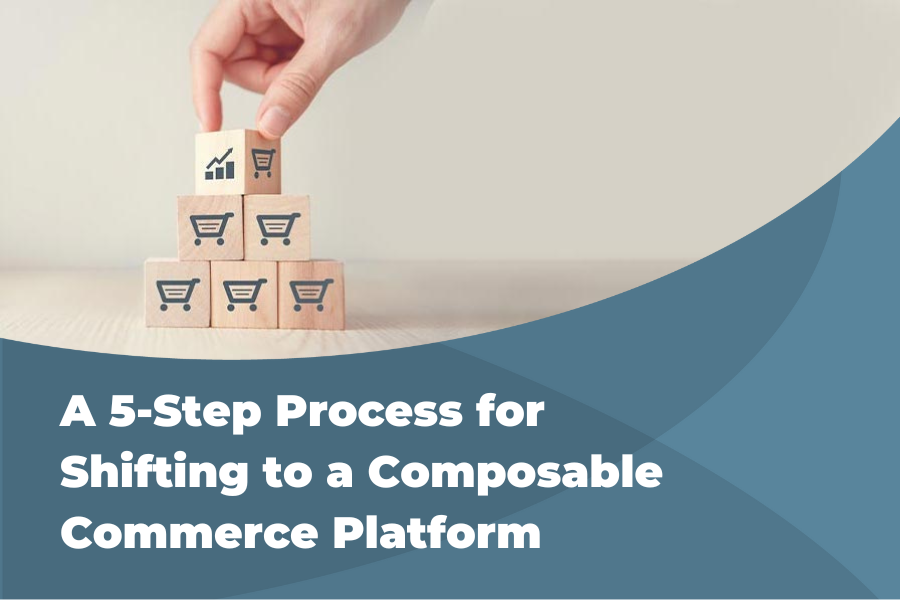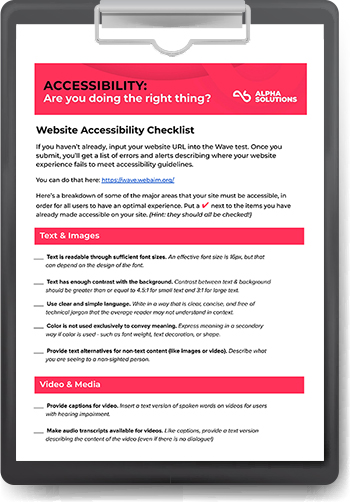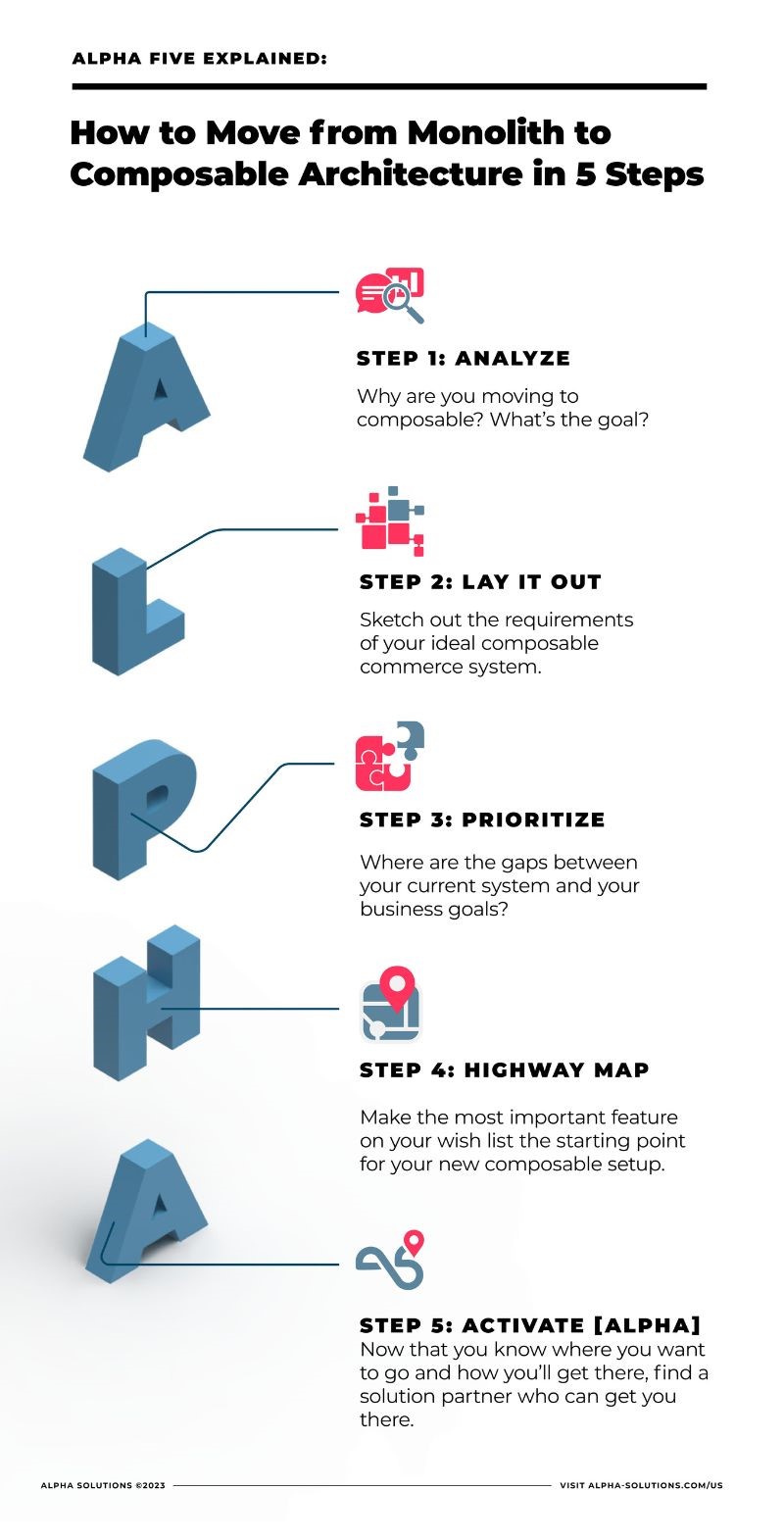If you’re starting to look into composable commerce, chances are that current retail trends are beginning to make an impact on your business. You’re not alone.
Consumer behavior is constantly changing, inflation is on the rise, and the only thing we know for sure is that it’s impossible to predict the future!
We’re all being more careful about how we spend our money and are doing more research before we buy. And, of course, we’re conducting as much business as possible online.
For retailers where business has mostly been conducted in-store, there’s now pressure to
… 🚚 accommodate for multiple delivery options,
… ↩️ allow for online returns,
… 📧 deploy perfectly-timed automated email flows,
… 🔒ensure tight and secure systems,
… ⏱️ provide quick customer support,
…and the list goes on.
Change is clearly nothing new in the world of retail, but the speed of change we’re seeing today is higher than ever… as is overall unpredictability.
The pandemic definitely helped retailers embrace e-commerce in a hurry. And that focus has to remain as we face more uncertainty in the coming years.
What challenges should e-commerce and retail businesses be preparing for in 2023 and beyond?
Here’s how to prepare your business for an unpredictable future -
If you’re not already doing so, consider making the move to composable commerce.
What is composable commerce?
(And why should you care?)
Imagine each of the different e-commerce features of your business as LEGO bricks.
You have a brick for:
- Commerce actions, such as Add to cart, Checkout etc.
- Live chat
- Online subscription service
- Transactional emails
- Personalized search
- Product recommendations
And so on.
Depending on what you want to offer your customers, you can simply stack them together to build whatever you want.
This is a simplified explanation of how composable architecture works. You essentially “compose” the commerce system that suits your needs.
If you’re not using composable architecture, you’re working with monolithic architecture.
That’s more similar to a Barbie Dream House. It might look pretty, but it takes a long time to put together, has a lot of features you may never use, and you can’t build onto it if you outgrow it - or at least - it’s hard and expensive.
However, going “composable" allows you to “compose” an agile commerce system that suits your unique business needs. Nothing more, nothing less.
Composable commerce gives you the ability to adjust your tech and your business processes as your consumers’ behaviors change.
As much as we love composable systems, there are pros and cons:
Composable systems are not for every business. Whether composable is the best choice for you or not will depend on factors – including whether or not you have a partner who can successfully manage all the facets of a composable system.
Let’s look at a list of composable commerce pros:
✅ PRO: Pay for what you need and use.
When you license big software suites, you will most likely pay for several features you never use.
Or you may have spent more on a system with a feature you really thought could be great. Then you find out it has become irrelevant, and you’re paying a premium for an unused feature.
With composable commerce, you only pay for the features that you need.
✅ PRO: Be less dependent on a single vendor.
When “composing” your solution from various vendors you will be less dependent on a single vendor.
This is an important feature of building composable systems. Yes, you can choose all the components you need from the same vendor, but beware that you don’t end up creating a dependency between these components.
No matter what, you need to make sure that you Orchestrate your solution using low-code/no-code techniques, tools or patterns to have all components loosely coupled. If you don’t do that, you’ll end up with a Monolith solution with a lot of glue-code, and the worst of its kind: a 100% custom-made Monolith. 😱
Some vendors obviously provide a full palette of composable components and services to build out your new composable setup. They often have some benefits as they integrate well, out of the box. But as mentioned above - be mindful of dependency.
✅ PRO: Speed to market & faster feature deployment.
By using cloud-based composable components, you can add new features easily. You don’t have to worry about hosting or upgrade fees. And development is much faster, as there’s no system to be installed or executed by developers.
With composable architecture, everything is built on APIs.
✅ PRO: Customization to the max.
Because you pick and choose each of the components for composable systems, you will end up with a highly customized composable infrastructure.
In doing this, you can “compose” a unique solution that solves and/or supports your specific business needs and goals while meeting the needs of your customers.
If you don’t believe this is key to you and your business, you might choose a simple setup that doesn’t necessarily need to be composable.
✅ PRO: Cost reduction & ease of management and hosting.
MACH architecture will simplify your management and hosting. The only thing you have to handle is your storefront and/or the middleware that “glues” the composable components together.
And if you don’t want to manage that, your preferred development partner should be able to provide such a service. Only choosing the components you need, with the features needed, should bring your development costs down compared to a full-blown system with all the bells and whistles. If not, something’s wrong.
✅ PRO: Improved performance.
Moving to a composable commerce platform doesn’t have to mean a change in frontend technology, but will probably include a JamStack approach using “new” technologies such as NextJs, React, VUE etc., which increase site speed and overall SEO.
Online shoppers have come to expect seamless experiences and have developed short attention spans. Taking a composable approach means access to new technologies, that will provide your customer with a better (faster) experience.
|
How accessible is your website? Get our free accessibility checklist to guide your efforts for getting compliant and doing the right thing. Plus, receive real feedback from us to help you on your next steps. |
Now for the composable commerce cons:
👎🏼 CON: Increased responsibility and ownership.
With composable systems, you’ll have multiple vendors providing services, which means multiple SLAs (Service Level Agreements). This means there’s a higher chance of “finger pointing” when something isn’t working as it should. This can leave you and your business in a difficult position. There are multiple solutions for this problem. The easiest being to entrust the management of all this to a partner like Alpha Solutions.
👎🏼 CON: Lack of proper tooling.
As composable solutions are put together from different services/components provided by different vendors there’s an obvious drawback: the tools are different and not a single tool has the same UI.
You might have to handle personalization outside your CMS, or promotions outside your commerce system.
More and more components offer Admin APIs so that tools can be integrated to give a fully integrated experience. That will be custom, sure, but will make sense for productivity, and to only handle features that’s actually needed.
👎🏼 CON: Inconsistency and solution partner dependency.
Whether you develop your commerce solutions in-house or with help from a partner, there’s always the risk of creating a dependency to the solution provider or key developers. That goes for both composable architecture and a monolith solution.
In the monolith software world some systems put a lot of constraints on how things can be customized, and what new features can be added.
In the composable world it’s a little more unclear. If your solution provider isn’t on top of processes and code-level architecture, rules, reviews etc., you can easily end up creating a glue-code-monster 👹.
This is important, as one of the key reasons for going composable is to have independent components that can be switched out as needed. New composable solutions, or any solution really, should use an orchestration layer based on a low-code/no-code strategy.
Your solution provider must have the needed skills to provide that for you!
👎🏼 CON: Low composability maturity and lack of skills needed by the business.
True composability consists of composable thinking, composable business architecture and then composable technology.
This is an important aspect of “composable” and one that’s often left out.
Maybe your business is not in a spot where composable architecture makes sense, or maybe you do not currently have the capacity to train your teams to a variety of new components or administrative UIs.
When going composable – you’ll have to look at the entire process as a whole – you should not look at technology alone.
Technology is important, but it is only there to support your business and drive your success – composable or not.
If you’re ready to make the move to composable commerce but don’t know where to start, simply follow the ALPHA FIVE process: Analyze, Lay it Out, Prioritize, Highway Map, Activate.
ALPHA FIVE Explained:
How to move from monolith to composable architecture
|
A |
STEP 1: Analyze
Prioritize them so you’re clear on what you want to change sooner than later. Answer the following questions:
|
|
L |
STEP 2: Lay it out
Be sure to add general requirements like expectations around timing and costs for bringing a new feature live, response times, and up times. You don’t need a fancy tech diagram here; you just need to write down your requirements in a structured way. |
|
P |
STEP 3: Prioritize
Write down those gaps – again in structured form, so you can see where your priorities are. |
|
H |
STEP 4: Highway map
Answer these questions:
As an example, your priority could be a subscription feature. If so, you must identify or get help to identify a service/vendor that provides the subscription feature you need. That could be your first step towards a composable setup. This is where you’ll research the market for components you need to follow your map, based on your key priorities. This step is often handled by a solution partner, or done in partnership with a solution partner. This is also where detailed business and technical requirements will be established, together with SLA and other legal requirements. |
|
A |
STEP 5: Activate (Alpha)
If you have a solution partner, make sure that partner is on the top of their game. Seriously consider re-occurring reviews from a 2nd partner (like you should always do in development projects). Think of composable commerce projects as something that must last a lifetime. Remember with composable architecture you will not do “lift and shifts” anymore – so you only upgrade or switch out individual components. Therefore, custom pieces in a composable system should last for a long time. So, high quality and low maintenance is key to making that possible. Be sure you include Orchestration from the start to avoid complex glue-code so you can handle the integrations between components. There are various options for doing this and your tech partner will be able to take care of this for you. |
Conclusion on Composable Commerce
A move to composable architecture will protect your business as we head into an uncertain future. And the move can be made in many different ways.
How you make the move to composable is up to you, your business priorities, and a bunch of other dependencies. That’s always the reality, especially when it comes to e-commerce.
But keep in mind that choosing composable commerce doesn’t have to be limited to a specific service or component. Think outside the box!
You might find a smaller piece of your current site where you start implementing a piece of the UI using a newer technology that you need for the future setup.
An example could be as simple as several static pages or landing pages that, in the old system, are generated using razor views, but in the new composable system, will be pre-rendered using next.js and served as static generated pages.
This could be done as a POC to prove, Page Load performance, and development speed and productivity.
Again – this depends on business priorities, budget, timelines etc. Our recommendations are, as with any project, to do your homework.
Focus on business priorities and specifications, then reach out to solutions providers who can help with planning and execution of the projects and your highway map. If you do that, your enterprise should be future proof.
At Alpha Solutions, we are at the forefront of the composable revolution. We thrive in complex environments that we can tear apart and build back up to be as simple as possible.
To give you an example of a composable commerce storefront, we’ve built a live demo on a Composable Tech Stack, React Storefront, and it’s running on Vercel. This demo includes all the features you would need for your online store, and remember, it’s composable. You can switch out components as you need, for your situation. Let’s say you already have an email campaign system like Responsys - if you’re happy with it you can keep on using that.
Reach out if you have any questions or if you’d like to request a demo. Unsure of your next tech step? Take our free quiz!









